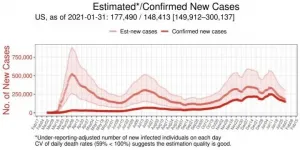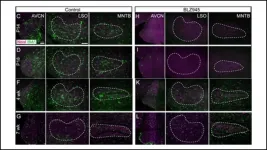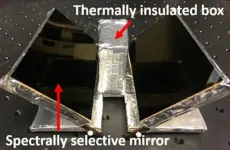(Press-News.org) Systems designed to detect deepfakes --videos that manipulate real-life footage via artificial intelligence--can be deceived, computer scientists showed for the first time at the WACV 2021 conference which took place online Jan. 5 to 9, 2021.
Researchers showed detectors can be defeated by inserting inputs called adversarial examples into every video frame. The adversarial examples are slightly manipulated inputs which cause artificial intelligence systems such as machine learning models to make a mistake. In addition, the team showed that the attack still works after videos are compressed.
"Our work shows that attacks on deepfake detectors could be a real-world threat," said Shehzeen Hussain, a UC San Diego computer engineering Ph.D. student and first co-author on the WACV paper. "More alarmingly, we demonstrate that it's possible to craft robust adversarial deepfakes in even when an adversary may not be aware of the inner workings of the machine learning model used by the detector."
In deepfakes, a subject's face is modified in order to create convincingly realistic footage of events that never actually happened. As a result, typical deepfake detectors focus on the face in videos: first tracking it and then passing on the cropped face data to a neural network that determines whether it is real or fake. For example, eye blinking is not reproduced well in deepfakes, so detectors focus on eye movements as one way to make that determination. State-of-the-art Deepfake detectors rely on machine learning models for identifying fake videos.
The extensive spread of fake videos through social media platforms has raised significant concerns worldwide, particularly hampering the credibility of digital media, the researchers point out. ""If the attackers have some knowledge of the detection system, they can design inputs to target the blind spots of the detector and bypass it," " said Paarth Neekhara, the paper's other first coauthor and a UC San Diego computer science student.
Researchers created an adversarial example for every face in a video frame. But while standard operations such as compressing and resizing video usually remove adversarial examples from an image, these examples are built to withstand these processes. The attack algorithm does this by estimating over a set of input transformations how the model ranks images as real or fake. From there, it uses this estimation to transform images in such a way that the adversarial image remains effective even after compression and decompression.??
The modified version of the face is then inserted in all the video frames. The process is then repeated for all frames in the video to create a deepfake video. The attack can also be applied on detectors that operate on entire video frames as opposed to just face crops.
The team declined to release their code so it wouldn't be used by hostile parties.
High success rate
Researchers tested their attacks in two scenarios: one where the attackers have complete access to the detector model, including the face extraction pipeline and the architecture and parameters of the classification model; and one where attackers can only query the machine 

learning model to figure out the probabilities of a frame being classified as real or fake. In the first scenario, the attack's success rate is above 99 percent for uncompressed videos. For compressed videos, it was 84.96 percent. In the second scenario, the success rate was 86.43 percent for uncompressed and 78.33 percent for compressed videos. This is the first work which demonstrates successful attacks on state-of-the-art deepfake detectors.
"To use these deepfake detectors in practice, we argue that it is essential to evaluate them against an adaptive adversary who is aware of these defenses and is intentionally trying to foil these defenses," the researchers write. "We show that the current state of the art methods for deepfake detection can be easily bypassed if the adversary has complete or even partial knowledge of the detector."
To improve detectors, researchers recommend an approach similar to what is known as adversarial training: during training, an adaptive adversary continues to generate new deepfakes that can bypass the current state of the art detector; and the detector continues improving in order to detect the new deepfakes.
INFORMATION:
Adversarial Deepfakes: Evaluating Vulnerability of Deepfake Detectors to Adversarial Examples
*Shehzeen Hussain, Malhar Jere, Farinaz Koushanfar, Department of Electrical and Computer Engineering, UC San Diego
Paarth Neekhara, Julian McAuley, Department of Computer Science and Engineering, UC San Diego
The Atala butterfly (Eumaeus atala) and its five closest relatives in the genus Eumaeus like to display their toxicity. This sextet's toxicity comes from what they eat as caterpillars: plants called cycads that have been around since before dinosaurs roamed the Earth and contain a potent liver toxin called cycasin.
Because they are filled with poison, Eumaeus are big, gaudily iridescent and flap about like they have no place to go. Even their caterpillars are conspicuous, congregating in groups to munch cycad plants all while sporting flashy red and gold ...
CLEVELAND - A Cleveland Clinic-led team of researchers has developed a personalized genomic medicine platform that will help advance accelerate genomic medicine research and genome-informed drug discovery, according to new study results published recently in END ...
CHICAGO --- Northwestern University professor and researcher Linda Teplin will discuss the psychosocial outcomes of incarcerated youth at the virtual 2021 American Association for the Advancement of Science (AAAS) annual meeting.
Teplin will moderate the scientific session "Consequences of Incarceration on Health Inequity and Racial Injustice" at 2 p.m. EST, Monday, Feb. 8. During the session, she will also present "Consequences of Incarceration in Detained Youth: A 15-Year Longitudinal Study."
Nearly 2.2 million Americans are incarcerated annually, ...
A new machine-learning framework uses reported test results and death rates to calculate estimates of the actual number of current COVID-19 infections within all 50 U.S. states and 50 countries. Jungsik Noh and Gaudenz Danuser of the University of Texas Southwestern Medical Center present these findings in the open-access journal PLOS ONE on February 8, 2021.
During the ongoing pandemic, U.S. states and many countries have reported daily counts of COVID-19 infections and deaths confirmed by testing. However, many infections have gone undetected, resulting in under-counting of the total number of people currently infected at any ...
(Santa Barbara, Calif.) -- Researchers in the labs of Christopher Bates, an assistant professor of materials at UC Santa Barbara, and Michael Chabinyc, a professor of materials and chair of the department, have teamed to develop the first 3D-printable "bottlebrush" elastomer. The new material results in printed objects that have unusual softness and elasticity -- mechanical properties that closely resemble those of human tissue.
Conventional elastomers, i.e. rubbers, are stiffer than many biological tissues. That's due to the size and shape of their constituent polymers, which are long, linear molecules that easily entangle like cooked spaghetti. In contrast, bottlebrush polymers ...
Classifying a death as suicide may be easiest for medical examiners and coroners in the western United States, which reports the highest suicide rates officially. Suicide by firearm is the leading method there, and usually clear in terms of evidence.
By contrast, suicides by drug overdose, spurred primarily by the opioid epidemic in the remainder of the country, are less obvious to investigators.
But a new West Virginia University-led injury mortality study combines most drug overdose deaths with all suicides into an expanded self-injury category. Exposing a mental health crisis that has unraveled across the United States over the past two decades, study data have direct implications for suicide prevention efforts.
Ian Rockett, professor ...
Auditory pathways in the brainstem do not fully mature without microglia clearing away extra cell connections. This crucial function occurs even when pruning by microglia is delayed, according to new research published in eNeuro.
Sensitive hearing requires precise connections between neurons in the auditory brainstem. Early in development, support cells called microglia prune away unnecessary connections and encourage others to expand. Microglia finish their job around two weeks after birth, but the rigidity of this developmental timeframe is unknown.
Milinkeviciute et al. eliminated microglia from the brains of newborn mice using a drug. They stopped the treatment after 10 days, and microglia returned to the brainstem. Initially, the mice with delayed microglia development ...
During every instant of life, over a hundred trillion microbes, collectively known as the microbiome, reside on skin surfaces and course through the human body. In the human gut, vast colonies of bacteria, belonging to around 1000 different species, carry out duties ranging from the digestion of food and the management of body weight to effects on the brain and behavior, many of these still elusive to science.
Recent studies in mice and humans have revealed intriguing links between the composition of gut microbiota and Autism Spectrum Disorder (ASD), a disease believed to affect ...
BUFFALO, N.Y. -- Passive cooling, like the shade a tree provides, has been around forever.
Recently, researchers have been exploring how to turbo charge a passive cooling technique -- known as radiative or sky cooling -- with sun-blocking, nanomaterials that emit heat away from building rooftops. While progress has been made, this eco-friendly technology isn't commonplace because researchers have struggled to maximize the materials' cooling capabilities.
New research led by University at Buffalo engineers makes significant progress in this area.
A study published Feb. 8 in the journal Cell Reports Physical Science describes a uniquely designed radiative cooling system that:
Lowered the temperature inside ...
Ebola and Marburg are among the most deadly viruses, with mortality rates from these infections ranging from 25% to 90%. While no drugs currently are available on the market to prevent infection from these viruses -- they belong to a category of viruses called filoviruses, which are known to cause hemorrhagic fever -- researchers have identified a few small drug molecules that can block filoviruses from infecting cells by occupying a single site on a glycoprotein in the virus.
Now, researchers at the END ...





